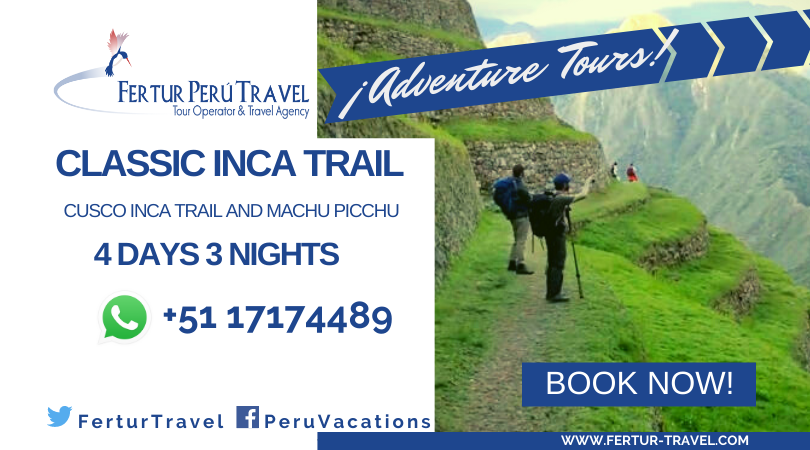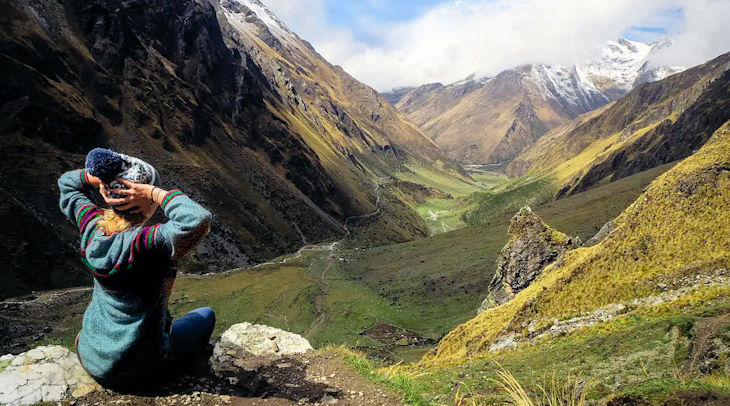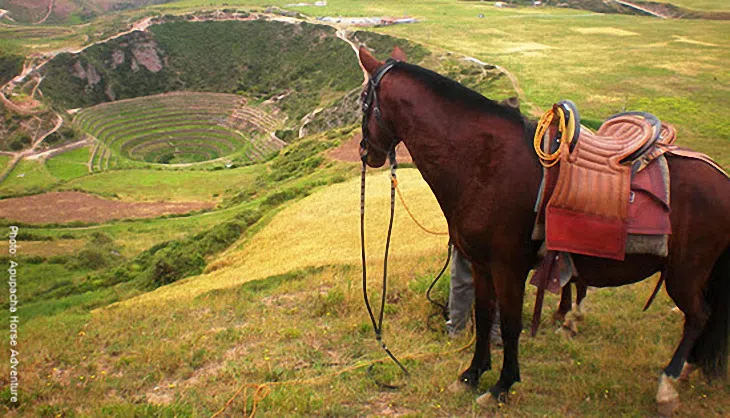Adventure tours in Peru offer a perfect balance of adrenaline pumping delight, spiritual fulfillment and a deep sense of personal achievement.
The abundance and variety of thrilling activities is staggering. Climb that Inca mountain, conquer those white water rapids and explore the lesser known trails.
Green hillsides, valley streams and colorful flowers will surround you. You’ll see grazing alpacas, llamas, horses and sheep, and snowy peaks shining in the distance. Landscapes full of colors and life.
But basking in that bright sunshine and blue sky first requires getting up at dawn — sleepy and cold, and climbing into a minibus or boarding a train to reach the trail head.
Once you embark, though, you’ll take in the natural wonders that surround you. You’ll appreciate all the talk about Pachamama — why mother nature, the living world, and that of the dead, are central to Andean beliefs.
The tradition of sacrifice to mother nature rose over thousands of years of being so exposed to her forces. This is why the adventure tours in Peru so often include some small offering to the Pachamana. The offering is usually a small colorful gift of flowers or a pour of chicha beer onto the ground.

What makes the Inca Trail to Machu Picchu the most “classic” adventure tour in Peru?
First there is the huge popularity of the 26-mile (42km), four-day trek. Second, it is a 15th century marvel of Inca engineering. Moreover, encompasses an incomparable variety of ecological zones and micro-climates and archaeological wonders. All that is exquisitely packed into a four-day hike.
Any fit, experienced and acclimatized hiker will not have a problem with the Inca Trail.
And even for the less experienced, the route is of medium difficulty.
So even though most people find it quite challenging, if you are in reasonably good condition — and can handle thousands of stairs — you can tackle the Inca Trail.
The Inca Trail entails major physical exertion at high altitude — 13,779 feet above sea level (4200m) at its highest point at Paso de Warmihuañusca or “Dead Woman’s Pass”.
Before the hike, you need to give yourself time to acclimatize. If you come to Cusco from sea level, plan on at least 2 full days minimum to spend in Cusco before starting this trek. (The same is true for all of the adventure tours described below.)
You also have to think about preparing your legs and knees for the greatest sustained workout they’re probably ever going to get.
There is no official count of the stone steps along the full length of the Inca Trail. But on the second day of the trek — the most challenging — most of the ascent to Dead Woman’s Pass is up uneven stone stairs.
On day three, the steep descent from puna grassland into the lush cloud forest involves a seemingly endless stone stairway of 3,000 steps.
Good quality hiking boots are a must, and hiking poles are very highly recommended.
No, you can only do the Inca Trail with a certified Inca Trail operator authorized to obtain your entry permit. Inca Trail trips run year round, except February, when the Trail is closed for repairs and restoration. April to October is the best period for this route, as this is the dry season with low rainfall in the southern mountains of Peru.
From May to August is “high season” when entry permits are most likely be sold out. So if you are going to hike during this period, book the trip several months in advance.
This shorter Inca Trail trek is the best Machu Picchu hiking tour for travelers with less time.
The hike begins at Chachabamba, or Km 104. The distance of this Inca Trail is under 7½ miles (12 Kms) and doable in 4 to 6 hours.
This shorter version of the Inca Trail is much less arduous than the longer route. And it still allows you to visit the most beautiful ruins on the way to Machu Picchu called Wiñayhuayna (Winawayna). After lunch we will continue through the Sun Gate (Inti Punku) for your first look at the Lost City of the Inca.
We will pass through Machu Picchu and descend to the village of MachuPicchu Pueblo (Aguas Calientes). After your check-in at the hotel, dinner is waiting for you.
For those who want a little taste of hiking in the Andes on roads built by the Inca, this hike with the next day spent in Machu Picchu is the best option.

Vinicunca, or “Rainbow Mountain” fully emerged from permanent snow cover in 2013. That revealed the now world-famous vivid stripes formed by trace minerals of iron oxide red, bright yellow iron sulphide and varying shades of chlorite green.
The “seven-colored mountain” quickly became Cusco’s most popular tourist destination, second only to Machu Picchu.
Vinicunca is reached by most travelers as a day trip from Cusco that begins well before dawn and takes six-hour journey to reach the wind-swept summit. That includes a three-hour drive to the Ccayahuire Valley and trail head near the town of Chillca, and then a three-hour trek to Rainbow Mountain.
The summit is more than 17,000 feet above sea level (5200m), so being acclimatized is very important.
We offer a more fulfilling route for the adventure traveler. It’s a challenging four-day, high-altitude circuit around Ausangate, the ice peaked mountain Apu, or natural deity.
The trek culminates a descent that brings the giant kaleidescope mountain range into sharper and ever closer view.

The five-day Salkantay trek to Machu Picchu is where colossal snow-capped mountains and lush rainforest meet.
The spectacular ice-packed summit of Mount Salkantay has been considered sacred since ancient times, protecting the local people and their crops. Towering more than 20,500 feet above sea level (6,270 m.a.s.l.), it is the highest peak of Cordillera Vilcabamba.
The name Salkantay derives from a Quechua word, meaning invincible, wild or savage. For this reason, Salkantay is often referred to as the “Savage Mountain.”
You might consider that apt when you reach 15,256 feet (4650m) on the second day of the circuit. This mountain inspires respect.
The Salkantay hike was named one of the 25 best treks in the world by National Geographic. Unlike the Inca Trail trek, Salkantay has no entry restrictions.
Passing through Mollepata to Machu Picchu, the Salkantay route is an ancient and remote trail. It ranges from mountainous, passing at the glacial line, then descends through the tropical jungle.
The Salkantay trek specially designed as an alternative to the traditional Inca Trail hike. Away from the crowds, this trek will provide a great experience for hikers seeking privacy and being one with nature.
With breathtaking views of the beauty of the Andes, this trek will lead you to Machu Picchu in unforgettable fashion.
The Ausangate Glacier is the fifth highest mountain in Peru at 20,945 feet above sea level (6384 m.a.s.l.). With its snow-capped peaks, it is the highest, most imposing mountain in southern Peru, visible from Cusco under clear skies.
The trek around Ausangate takes you into the heartland of the Q’eros people, direct descendants of the Inca. Their small villages have remained largely unchanged for centuries.
The Ausangate hiking circuit is the most challenging adventure travel route in the region. It takes between five and six days to complete and crosses several mountain passes 6,000 feet (5,000m). This trek is for experienced hikers, not beginners.
You’ll ascend up through brown rocky prairies of the Andean plateau, populated by herds of grazing llamas, alpacas and sheep. As you reach the higher altitudes, there are beautiful turquoise lagoons and different rock formations. The descent leads through lush, swampy green valleys.
The starting and ending point is Tinqui, where you can bathe in the natural hot springs.

This full-day horseback riding tour of Cusco’s Sacred Valley takes you on a whole different route through Spanish colonial villages and the Andean countryside.
You will get alternative views of Inca archaeological sites, including the Quechuyuc Muyu, the central terraced monument of Moray.
Riding Peruvian Paso horses, you will be accompanied by a private guide. The excursion includes a picnic lunch. And it concludes with a guided tour of the Maras Salt Flats, a stunning patchwork of some 3,000 “salt pans” that predates the Inca civilization.
The Peruvian Paso horse are renowned as smoothest riding horse in the world. They are considered the best saddle horse due to the smoothness of their gait, easy handling and stable temperament. The sub equine breed is descended from Andalusian and Arabian horses, which were first brought to Peru by the Spanish Conquistadors.
Discover Peru’s unparalleled bird diversity with Cusco tours, where the fusion of cultural heritage and natural beauty offers an exceptional bird-watching experience. Peru, home to the world’s highest number of bird species, invites travelers to explore its vibrant avian life. From the Sacred Valley’s serene landscapes to the enigmatic ruins of Machu Picchu, each destination presents a unique opportunity to encounter rare and endemic birds.
For an unforgettable journey into the heart of Peru’s bird paradise, tailored to enthusiasts and photographers alike, review Fertur Peru Travel’s birdwatching tours. Embark on a customized adventure that promises not just sightings but an immersive experience into the avian world.